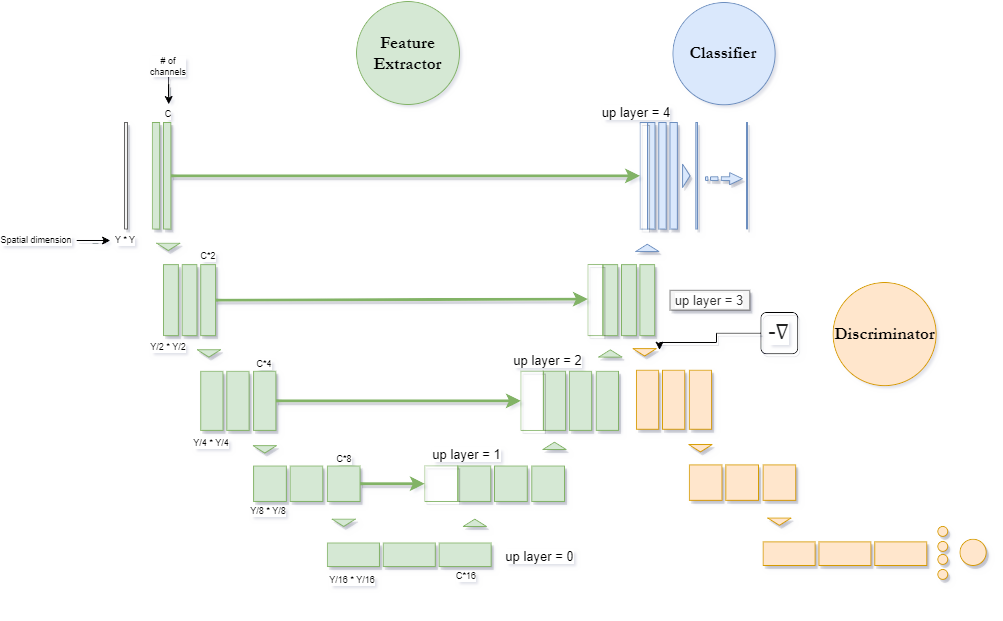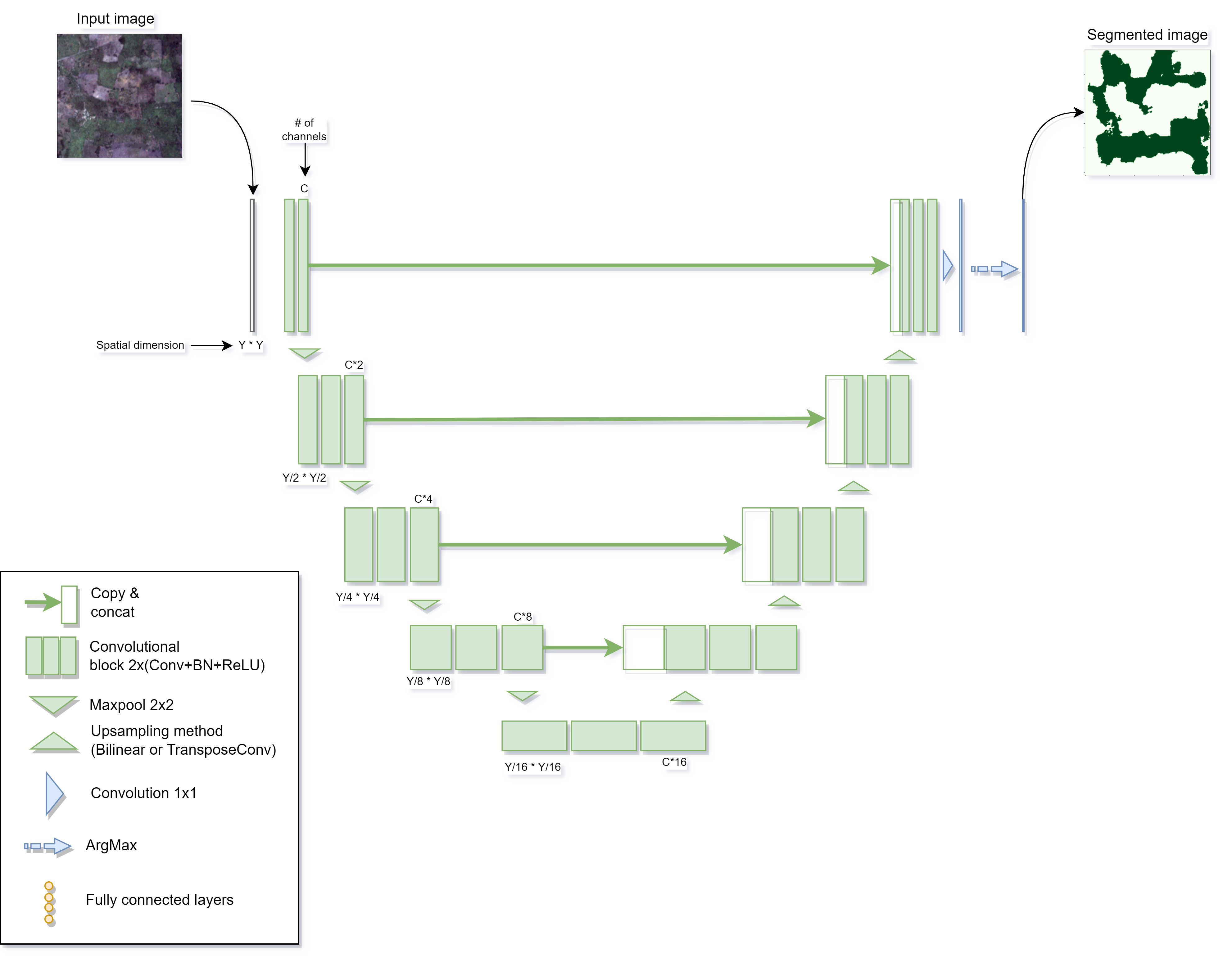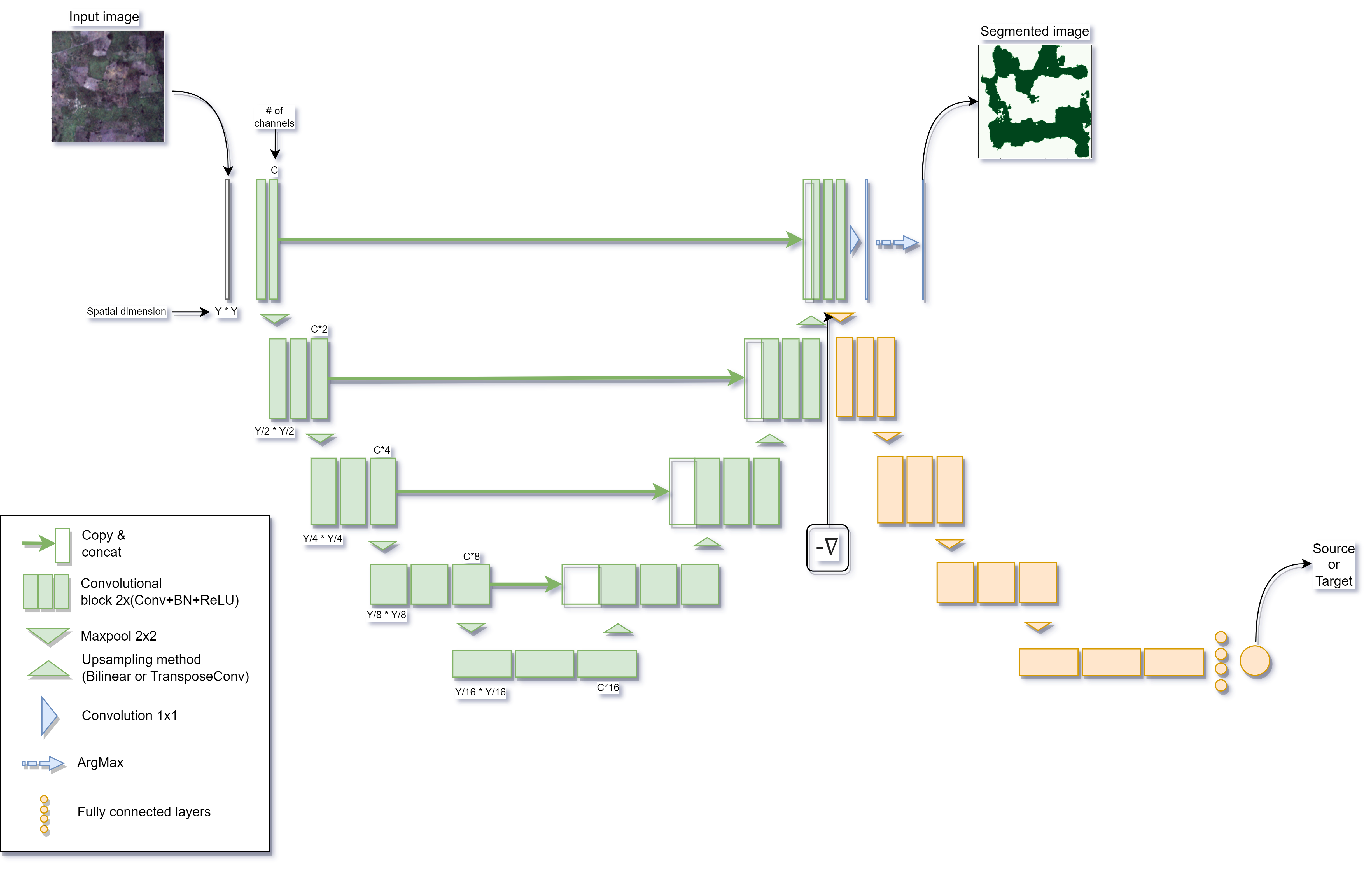U_Net
Brief description of the submodule
This submodule uses the building blocks from Buildingblocks to first build major blocks which consist of:
- FE: The feature extractor
- C: The classifier head of the U-Net and
- D: The discriminator head of the U-Net + DANN.
And secondly build the models used for segmentation U-Net and domain adaptation purposes (U-Net + DANN).
Major blocks

FE
Class containing the layers considered for the extraction of features from the 2D images.
This feature extractor can change its size depending on the layer in which it is decided to divide the U-Net into feature extractor and classifier.
The division of the U-Net was inspired by the implementation done by brion et al. (2019) for domain adaptation in 3D medical imagery.
Attributes
- self.n_channels: (int) Number of channels [bands] on the images that will enter the network.
- self.starter: (int) Number of feature maps obtained from the first double convolution performed. The number of feature maps obtained for every double convolution will be then calculated multiplying this value by , where is the level in the U_net, starting from 0 in the upmost layer and 2 in the lowest layer.
- self.up_layer: (int : [0-4]) Number indicating the layer in which the network is divided into Feature Extractor and Classifier.
- self.bilinear: (Boolean) Boolean indicating the method for upsampling in the expanding path. Default is True.
- self.attention: (Boolean) Boolean to indicate if attention gates will be added on the upsampling step. Default is False.
- self.resunet: (Boolean) Boolean used to indicate if the double convolution will have a residual connection or not. Default is False.
Methods
- DownSteps: Function to get the resulting feature maps of each of the steps performed on the contracting path of the U-Net.
- forward: Function to perform the forward calculation of the features extracted.
Source code
class FE(nn.Module):
"""
Class for the creation of the feature extractor.
"""
def __init__(self, n_channels, starter, up_layer, bilinear = True, attention = False, resunet = False):
super(FE, self).__init__()
self.n_channels = n_channels
self.starter = starter
self.bilinear = bilinear
self.up_layer = up_layer
self.attention = attention
self.resunet = resunet
# Layers related to segmentation task
self.inc = (DoubleConv(self.n_channels, self.starter, resunet = self.resunet))
self.down1 = (Down(self.starter, self.starter*(2**1), resunet = self.resunet))
self.down2 = (Down(self.starter*(2**1), self.starter*(2**2), resunet = self.resunet))
self.down3 = (Down(self.starter*(2**2), self.starter*(2**3), resunet = self.resunet))
factor = 2 if bilinear else 1
self.down4 = (Down(self.starter*(2**3), self.starter*(2**4) // factor, resunet = self.resunet))
if self.up_layer >= 1:
self.up1 = (Up(self.starter*(2**4), self.starter*(2**3) // factor, bilinear, attention, resunet = self.resunet))
if self.up_layer >= 2:
self.up2 = (Up(self.starter*(2**3), self.starter*(2**2) // factor, bilinear, attention, resunet = self.resunet))
if self.up_layer >= 3:
self.up3 = (Up(self.starter*(2**2), self.starter*(2**1) // factor, bilinear, attention, resunet = self.resunet))
if self.up_layer >= 4:
self.up4 = (Up(self.starter*(2**1), self.starter, bilinear, attention, resunet = self.resunet))
def DownSteps(self, x):
x1 = self.inc(x)
x2 = self.down1(x1)
x3 = self.down2(x2)
x4 = self.down3(x3)
x5 = self.down4(x4)
return x1, x2, x3, x4, x5
def forward(self, x):
# Downsample steps
x1, x2, x3, x4, x5 = self.DownSteps(x)
# Upsample steps
if self.up_layer == 0:
x = x5
if self.up_layer >= 1:
x = self.up1(x5, x4)
if self.up_layer >= 2:
x = self.up2(x, x3)
if self.up_layer >= 3:
x = self.up3(x, x2)
if self.up_layer >= 4:
x = self.up4(x, x1)
return x
C
Class containing the layers considered for the segmentation of the 2D images using the features extracted from FE
This classifier can change its size depending on the layer in which it is decided to divide the U-Net into feature extractor and classifier.
The division of the U-Net was inspired by the implementation done by brion et al. (2019) for domain adaptation in 3D medical imagery.
Attributes
==NEED TO REMOVE N_CHANNELS AS ATTRIBUTE ==
- self.starter: (int) Number of feature maps obtained from the first double convolution performed. The number of feature maps obtained for every double convolution will be then calculated multiplying this value by , where is the level in the U_net, starting from 0 in the upmost layer and 2 in the lowest layer.
- self.up_layer: (int : [0-4]) Number indicating the layer in which the network is divided into Feature Extractor and Classifier.
- self.bilinear: (Boolean) Boolean indicating the method for upsampling in the expanding path. Default is True.
- self.n_classes: (int) Number of classes in which the images will be classified. Default is 2.
- self.attention: (Boolean) Boolean to indicate if attention gates will be added on the upsampling step. Default is False.
- self.resunet: (Boolean) Boolean used to indicate if the double convolution will have a residual connection or not. Default is False.
Methods
- forward: Function to perform the forward calculation of the logits. It takes as an input both the features extracted in FE and the feature maps extracted from the downsampling steps which can be obtained with the DownSteps method.
Source code
class C(nn.Module):
def __init__(self, n_channels, starter, up_layer, bilinear = True, n_classes = 2, attention = False, resunet = False):
super(C, self).__init__()
self.n_channels = n_channels
self.bilinear = bilinear
self.starter = starter
self.up_layer = up_layer
self.n_classes = n_classes
self.attention = attention
self.resunet = resunet
factor = 2 if bilinear else 1
if self.up_layer == 0:
self.up1 = (Up(self.starter*(2**4), self.starter*(2**3) // factor, bilinear, attention, resunet = self.resunet))
self.up2 = (Up(self.starter*(2**3), self.starter*(2**2) // factor, bilinear, attention, resunet = self.resunet))
self.up3 = (Up(self.starter*(2**2), self.starter*(2**1) // factor, bilinear, attention, resunet = self.resunet))
self.up4 = (Up(self.starter*(2**1), self.starter, bilinear, attention, self.resunet))
self.outc = (OutConv(self.starter, n_classes))
elif self.up_layer == 1:
self.up2 = (Up(self.starter*(2**3), self.starter*(2**2) // factor, bilinear, attention, resunet = self.resunet))
self.up3 = (Up(self.starter*(2**2), self.starter*(2**1) // factor, bilinear, attention, resunet = self.resunet))
self.up4 = (Up(self.starter*(2**1), self.starter, bilinear, attention, resunet = self.resunet))
self.outc = (OutConv(self.starter, n_classes))
elif self.up_layer == 2:
self.up3 = (Up(self.starter*(2**2), self.starter*(2**1) // factor, bilinear, attention, resunet = self.resunet))
self.up4 = (Up(self.starter*(2**1), self.starter, bilinear, attention, resunet = self.resunet))
self.outc = (OutConv(self.starter, n_classes))
elif self.up_layer == 3:
self.up4 = (Up(self.starter*(2**1), self.starter, bilinear, attention, resunet = self.resunet))
self.outc = (OutConv(self.starter, n_classes))
elif self.up_layer == 4:
self.outc = (OutConv(self.starter, n_classes))
def forward(self, x, dw):
# Downsample steps
x1, x2, x3, x4, x5 = dw
# Upsampling steps
if self.up_layer == 0:
x = self.up1(x5, x4)
x = self.up2(x, x3)
x = self.up3(x, x2)
x = self.up4(x, x1)
logits = self.outc(x)
elif self.up_layer == 1:
x = self.up2(x, x3)
x = self.up3(x, x2)
x = self.up4(x, x1)
logits = self.outc(x)
elif self.up_layer == 2:
x = self.up3(x, x2)
x = self.up4(x, x1)
logits = self.outc(x)
elif self.up_layer == 3:
x = self.up4(x, x1)
logits = self.outc(x)
elif self.up_layer == 4:
logits = self.outc(x)
return logits
D
Class containing the layers used to discriminate between the source and target domain using the features extracted in FE.
The discriminator first downsamples the features using the same class Down used in the contracting path of the U-Net. Then, a fully connected layer is used to discriminate between source and target domain.
Attributes
- self.initial_features: (int) Number of features that will go into the final fully connected layer.
- self.starter: (int) Number of feature maps obtained from the first double convolution performed. The number of feature maps obtained for every double convolution will be then calculated multiplying this value by , where is the level in the U_net, starting from 0 in the upmost layer and 2 in the lowest layer.
- self.up_layer: (int : [0-4]) Number indicating the layer in which the network is divided into Feature Extractor and Classifier.
- self.bilinear: (Boolean) Boolean indicating the method for upsampling in the expanding path. Default is True.
- self.resunet: (Boolean) Boolean used to indicate if the double convolution will have a residual connection or not. Default is False.
- self.grad_rev_w: (float) Number with the learning weight of the discriminator head. Default is 1.
Methods
- forward: Function to perform the forward calculation of the logits. This function takes the features extracted from FE and the value of grad_rev_w, which is the same as constant from GradReverse.
Source code
class D(nn.Module):
def __init__(self, initial_features, bilinear=True, starter = 8, up_layer = 3, resunet = False, grad_rev_w = 1):
super(D, self).__init__()
self.initial_features = initial_features
self.bilinear = bilinear
self.starter = starter
self.up_layer = up_layer
self.resunet = resunet
self.grad_rev_w = grad_rev_w
factor = 2 if bilinear else 1
self.revgrad = GradReverse.grad_reverse
self.outd = (OutDisc(self.initial_features, 256))
if self.up_layer > 0:
self.down4_D = (Down(self.starter*(2**3)//factor, self.starter*(2**4)//factor, resunet = self.resunet))
if self.up_layer > 1:
self.down3_D = (Down(self.starter*(2**2)//factor, self.starter*(2**3)//factor, resunet = self.resunet))
if self.up_layer > 2:
self.down2_D = (Down(self.starter*(2**1)//factor, self.starter*(2**2)//factor, resunet = self.resunet))
if self.up_layer > 3:
self.down1_D = (Down(self.starter, self.starter*2//factor, resunet = self.resunet))
def forward(self, x, grad_rev_w):
x = self.revgrad(x, grad_rev_w)
if self.up_layer == 1:
x = self.down4_D(x)
if self.up_layer == 2:
x = self.down3_D(x)
x = self.down4_D(x)
if self.up_layer == 3:
x = self.down2_D(x)
x = self.down3_D(x)
x = self.down4_D(x)
if self.up_layer == 4:
x = self.down1_D(x)
x = self.down2_D(x)
x = self.down3_D(x)
x = self.down4_D(x)
x = self.outd(x)
return x
Networks implemented
UNet
Class containing the layers used to create the custom UNet used to segment 2D images. An overview of the network can be seen here.
Overview

Attributes
- self.n_channels: (int) Number of channels [bands] on the images that will enter the network.
- self.n_classes: (int) Number of classes in which the images will be classified.
- self.bilinear: (Boolean) Boolean indicating the method for upsampling in the expanding path. Default is True.
- self.starter: (int) Number of feature maps obtained from the first double convolution performed. The number of feature maps obtained for every double convolution will be then calculated multiplying this value by , where is the level in the U_net, starting from 0 in the upmost layer and 2 in the lowest layer. Default is 8.
- self.up_layer: (int : [0-4]) Number indicating the layer in which the network is divided into Feature Extractor and Classifier. Default is 3.
- self.attention: (Boolean) Boolean to indicate if attention gates will be added on the upsampling step. Default is False.
- self.resunet: (Boolean) Boolean used to indicate if the double convolution will have a residual connection or not. Default is False.
Methods
- forward: Function to perform the forward calculation of the logits per class using images as an input.
- init_weights: Function to initialize the weights using the xavier normal method.
Source code
class UNet(nn.Module):
def __init__(self, n_channels, n_classes, bilinear=True, starter = 8, up_layer = 3, attention = False, resunet = False):
super(UNet, self).__init__()
self.n_channels = n_channels
self.n_classes = n_classes
self.bilinear = bilinear
self.starter = starter
self.up_layer = up_layer
self.attention = attention
self.resunet = resunet
self.FE = (FE(self.n_channels, self.starter, self.up_layer, self.bilinear, self.attention, resunet = self.resunet))
self.C = (C(self.n_channels, self.starter, self.up_layer, self.bilinear, self.n_classes, self.attention, resunet = self.resunet))
self.apply(self._init_weights)
def forward(self, x):
features = self.FE(x) # Feature extractor
down_st = self.FE.DownSteps(x) # Get channels that will be concatenated from downward steps
logits = self.C(features, down_st) # Classifier
return logits
def _init_weights(self, module):
if isinstance(module, nn.Conv2d):
nn.init.xavier_normal_(module.weight)
if module.bias is not None:
module.bias.data.zero_()
UNetDANN
Class containing the layers used to create the custom UNet-DANN network used to perform domain adaptation for sementing 2D images. This network uses the gradient reversal proposed by Ganin et al. (2016) on the U-Net semantic segmentation model.
Overview

Attributes
Methods
- forward: Function to perform the forward calculation of the logits per class and the logits per domain using images as an input. This networks has two heads, therefore it returns two results.
- init_weights: Function to initialize the weights using the xavier normal method.
Source code
class UNetDANN(nn.Module):
def __init__(self, n_channels, n_classes, bilinear=True, starter = 8, up_layer = 3, attention = False, resunet = False, DA = False, in_feat = None, grad_rev_w = 1):
super(UNetDANN, self).__init__()
self.n_channels = n_channels
self.n_classes = n_classes
self.bilinear = bilinear
self.starter = starter
self.up_layer = up_layer
self.attention = attention
self.resunet = resunet
self.in_feat = in_feat
self.DA = DA
self.FE = (FE(self.n_channels, self.starter, self.up_layer, self.bilinear, self.attention, resunet = self.resunet))
self.C = (C(self.n_channels, self.starter, self.up_layer, self.bilinear, self.n_classes, self.attention, resunet = self.resunet))
if DA:
self.D = (D(initial_features=self.in_feat, bilinear = self.bilinear, starter = self.starter, up_layer = self.up_layer, resunet = self.resunet, grad_rev_w = grad_rev_w))
self.apply(self._init_weights)
def forward(self, x, grad_rev_w = 0):
features = self.FE(x) # Feature extractor
down_st = self.FE.DownSteps(x) # Get channels that will be concatenated from downward steps
logits = self.C(features, down_st) # Classifier
dom_preds = self.D(features, grad_rev_w)
return logits, dom_preds
def _init_weights(self, module):
if isinstance(module, nn.Linear):
nn.init.xavier_normal_(module.weight)
if isinstance(module, nn.Conv2d):
nn.init.xavier_normal_(module.weight)
if module.bias is not None:
module.bias.data.zero_()